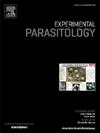Evaluation of β-caryophyllene(1–3) as a potential anti-tick molecule for controlling tick infestations on animals
IF 1.4
4区 医学
Q3 PARASITOLOGY
引用次数: 0
Abstract
Ageratum conyzoides (Family: Asteraceae), a common herbaceous weed has a long history of use in traditional medicine. Rhipicephalus microplus, the cattle tick is distributed globally and causing significant economic losses to the animal husbandry sectors. Due to repeated applications of chemical acaricides to control infestation on animals, the tick species developed resistance to most of the acaricides. In the present study, to manage the problem of resistant ticks, the potentiality of β-caryophyllene (1–3) is explored for its anti-tick efficacy against three important tick species. The LC95 value of β-caryophyllene (1–3) against reference susceptible IVRI-I strain of R. microplus was 0.0284 % (95 % CI = 266.5–299.4) while against multi-acaricide resistant field isolates it was 0.0507 % (95 % CI = 491.4–523.0). The compound was 95 % efficacious against Hyalomma anatolicum and R. annulatus ticks. The anti-tick efficacy of the compound after oral administration at the dose rate of 7.5 mg per kg body weight was tested under challenged infestation conditions and more than 80 % efficacy was noted. In a separate experiment, a 73.3–97.7 % (mean efficacy = 77.6 %) efficacy of β-caryophyllene (1–3) was noted for three months which was comparable and not significantly lower than the efficacy (95.8 %) observed in the amitraz treatment group of animals but significantly higher as compared to the control group of animals. The present study was focused on the identification of new plant derived anti-tick molecule having the acaricidal capability for the management of resistant tick infestations on animals.

β-石竹烯(1-3)作为潜在的抗蜱分子防治动物蜱害的评价。
菊苣(Ageratum conyzoides)是一种常见的草本杂草,在传统医学中有着悠久的使用历史。牛蜱微头蜱分布在全球,给畜牧业造成重大经济损失。由于多次使用化学杀螨剂防治动物虫害,导致蜱类对大多数杀螨剂产生抗药性。在本研究中,为了解决抗性蜱虫的问题,我们探索了β-石竹烯(1-3)对三种重要蜱虫的防蜱作用潜力。β-石竹烯(1-3)对参考敏感株ivri - 1的LC95值为0.0284% (95% CI= 266.5 ~ 299.4),对多重杀螨剂抗性田间分离株的LC95值为0.0507% (95% CI= 491.4 ~ 523.0)。该化合物对动物透明眼蜱和环纹蜱的有效率为95%。在攻虫条件下,以每公斤体重7.5 mg的剂量率口服该化合物,对蜱虫的防效达到80%以上。在另一项实验中,β-石竹烯(1-3)3个月的疗效为73.3-97.7%(平均疗效=77.6%),与阿米特拉兹治疗组的疗效(95.8%)相当,但不显著低于对照组,但明显高于对照组。本研究旨在鉴定具有杀螨能力的植物源抗蜱分子,用于防治动物体内的抗性蜱虫侵害。
本文章由计算机程序翻译,如有差异,请以英文原文为准。
求助全文
约1分钟内获得全文
求助全文
来源期刊

Experimental parasitology
医学-寄生虫学
CiteScore
3.10
自引率
4.80%
发文量
160
审稿时长
3 months
期刊介绍:
Experimental Parasitology emphasizes modern approaches to parasitology, including molecular biology and immunology. The journal features original research papers on the physiological, metabolic, immunologic, biochemical, nutritional, and chemotherapeutic aspects of parasites and host-parasite relationships.
 求助内容:
求助内容: 应助结果提醒方式:
应助结果提醒方式:


